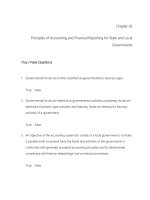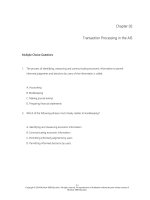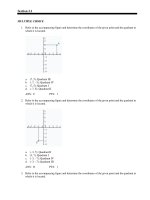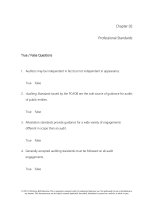Crafting and executing strategy 19th edition thompson test bank
Bạn đang xem bản rút gọn của tài liệu. Xem và tải ngay bản đầy đủ của tài liệu tại đây (553.68 KB, 115 trang )
Chapter 02
Charting a Company's Direction: Its Vision, Mission, Objectives, and
Strategy
Multiple Choice Questions
1.
Which one of the following is NOT one of the five basic tasks of the strategy-making, strategyexecuting process?
A. Developing a strategic vision of where the company needs to head and what its future business
makeup will be.
B. Setting objectives to convert the strategic vision into specific strategic and financial performance
outcomes for the company to achieve.
C. Crafting a strategy to achieve the objectives and get the company where it wants to go.
D. Developing a profitable business model.
E. Executing the chosen strategy efficiently and effectively.
2-1
© 2014 by McGraw-Hill Education. This is proprietary material solely for authorized instructor use. Not authorized for sale or distribution
in any manner. This document may not be copied, scanned, duplicated, forwarded, distributed, or posted on a website, in whole or part.
2.
A company's strategic plan:
A. maps out the company's history.
B. links the company's financial targets to control mechanisms.
C. outlines the competitive moves and approaches to be used in achieving the desired business
results.
D. challenges the company to maintain invariable objectives.
E. All of these.
3.
Which of the following tasks of the strategy-making, strategy-execution managerial process make
up the company's strategic plan?
A. Developing a strategic vision, mission, and core values.
B. Executing the strategy.
C. Monitoring developments, evaluating performance, and initiating corrective adjustments.
D. All of these.
E. None of these.
4.
Which of the following is an integral part of the managerial process of crafting and executing
strategy?
A. Developing a proven business model.
B. Deciding how much of the company's resources to employ in the pursuit of sustainable
competitive advantage.
C. Setting objectives and using them as yardsticks for measuring the company's performance and
progress.
D. Communicating the company's values and code of conduct to all employees.
E. Deciding on the company's strategic intent.
2-2
© 2014 by McGraw-Hill Education. This is proprietary material solely for authorized instructor use. Not authorized for sale or distribution
in any manner. This document may not be copied, scanned, duplicated, forwarded, distributed, or posted on a website, in whole or part.
5.
Which of the following are integral parts of the managerial process of crafting and executing
strategy?
A. Developing a strategic vision, setting objectives, and crafting a strategy.
B. Developing a proven business model, deciding on the company's strategic intent, and crafting a
strategy.
C. Setting objectives, crafting a strategy, implementing and executing the chosen strategy, and
deciding how much of the company's resources to employ in the pursuit of sustainable
competitive advantage.
D. Coming up with a statement of the company's mission and purpose, setting objectives,
choosing what business approaches to employ, selecting a business model, and monitoring
developments.
E. Deciding on the company's strategic intent, setting financial objectives, crafting a strategy, and
choosing what business approaches and operating practices to employ.
6.
The strategy-making, strategy-executing process:
A. is usually delegated to members of a company's board of directors so as not to infringe on the
time of busy executives.
B. includes establishing a company's mission, developing a business model aimed at making the
company an industry leader, and crafting a strategy to implement and execute the business
model.
C. embraces the tasks of developing a strategic vision, setting objectives, crafting a strategy,
implementing and executing the strategy, and then monitoring developments and initiating
corrective adjustments in light of experience, changing conditions, and new opportunities.
D. is principally concerned with sizing up an organization's internal and external situation, so as to
be prepared for the challenges of developing a sound business model.
E. is primarily the responsibility of top executives and the board of directors; very few managers
below this level are involved in the process.
2-3
© 2014 by McGraw-Hill Education. This is proprietary material solely for authorized instructor use. Not authorized for sale or distribution
in any manner. This document may not be copied, scanned, duplicated, forwarded, distributed, or posted on a website, in whole or part.
7.
A company's strategic vision describes:
A. "who we are and what we do."
B. why the company does certain things in trying to please its customers.
C. management's storyline of how it intends to make a profit with the chosen strategy.
D. management's aspirations for the future and delineates the company's strategic course and
long-term direction.
E. what future actions the enterprise will likely undertake to outmaneuver rivals and achieve a
sustainable competitive advantage.
8.
The real purpose of the company's strategic vision:
A. is management's story line for how it plans to implement and execute a profitable business
model.
B. sets forth what business the company is presently in and why it uses particular operating
practices in trying to please customers.
C. serves as management's tool for giving the organization a sense of direction.
D. defines "who we are and what we do."
E. spells out a company's strategic intent, its strategic and financial objectives, and the business
approaches and operating practices that will underpin its efforts to achieve sustainable
competitive advantage.
2-4
© 2014 by McGraw-Hill Education. This is proprietary material solely for authorized instructor use. Not authorized for sale or distribution
in any manner. This document may not be copied, scanned, duplicated, forwarded, distributed, or posted on a website, in whole or part.
9.
A strategic vision constitutes management's view and conclusions about the company's:
A. long-term direction and what product-market-customer mix seems optimal.
B. business model and the kind of value that it is trying to deliver to customers.
C. story line of why the business will be a moneymaker.
D. defined challenge to understand "who they are and what they do."
E. long-term plan for outcompeting rivals and achieving a competitive advantage.
10. The managerial task of developing a strategic vision for a company:
A. concerns deciding what approach the company should take to implement and execute its
business model.
B. entails coming up with a fairly specific answer to "who are we, what do we do, and why are we
here?".
C. is chiefly concerned with addressing what a company needs to do to successfully outcompete
rivals in the marketplace.
D. involves deciding upon what strategic course a company should pursue in preparing for the
future and why this directional path makes good business sense.
E. entails coming up with a persuasive storyline of how the company intends to make money.
11. Which one of the following is NOT an accurate attribute of an organization's strategic vision?
A. Providing a panoramic view of "where we are going".
B. Outlining how the company intends to implement and execute its business model.
C. Pointing an organization in a particular direction and charting a strategic path for it to follow.
D. Helping mold an organization's character and identity.
E. Describing the company's future product-market-customer-technology focus.
2-5
© 2014 by McGraw-Hill Education. This is proprietary material solely for authorized instructor use. Not authorized for sale or distribution
in any manner. This document may not be copied, scanned, duplicated, forwarded, distributed, or posted on a website, in whole or part.
12. Management's strategic vision for an organization:
A. charts a strategic course for the organization ("where we are going") and provides a rationale
for why this directional path makes good sense.
B. describes in fairly specific terms the organization's strategic intent, strategic objectives, and
strategy.
C. spells out how the company will become a big moneymaker and boost shareholder value.
D. addresses the critical issue of "why our business model needs to change and how we plan to
change it."
E. spells out the organization's strategic intent and the actions and moves that will be undertaken
to achieve it.
13. Well-conceived visions are ________ and ____________ to a particular organization and they avoid
generic, feel-good statements that could apply to hundreds of organizations.
A. widespread; unique
B. recurring; customary
C. distinctive; specific
D. customary; familiar
E. universal; established
2-6
© 2014 by McGraw-Hill Education. This is proprietary material solely for authorized instructor use. Not authorized for sale or distribution
in any manner. This document may not be copied, scanned, duplicated, forwarded, distributed, or posted on a website, in whole or part.
14. What a company's top executives are saying about where the company is headed long term and
about what the company's future product-market-customer-technology mix will be:
A. indicates what kind of business model the company is going to have in the future.
B. constitutes their strategic vision for the company.
C. signals what the firm's strategy will be.
D. serves to define the company's mission.
E. indicates what the company's long-term strategic plan is.
15. One of the important benefits of a well-conceived and well-stated strategic vision is to:
A. clearly delineate how the company's business model will be implemented and executed.
B. clearly communicate management's aspirations for the company to stakeholders and help steer
the energies of company personnel in a common direction.
C. set forth the firm's strategic objectives in clear and fairly precise terms.
D. help create a "balanced scorecard" approach to objective-setting and not stretch the company's
resources too thin across different products, technologies, and geographic markets.
E. indicate what kind of sustainable competitive advantage the company will try to create in the
course of becoming the industry leader.
2-7
© 2014 by McGraw-Hill Education. This is proprietary material solely for authorized instructor use. Not authorized for sale or distribution
in any manner. This document may not be copied, scanned, duplicated, forwarded, distributed, or posted on a website, in whole or part.
16. The defining characteristic of a well-conceived strategic vision is:
A. what it says about the company's future strategic course—"the direction we are headed and
what our future product-market-customer-technology focus will be."
B. that it not stretch the company's resources too thin across different products, technologies, and
geographic markets.
C. clarity and specificity about "who we are, what we do, and why we are here."
D. that it be flexible and in the mainstream.
E. that it be within the realm of what the company can reasonably expect to achieve within four
years.
17. Which one of the following questions is NOT pertinent to company managers in thinking
strategically about what directional path should be taken by the company and about developing a
strategic vision?
A. Is the outlook for the company promising if it continues with its present product offerings?
B. Are changing market and competitive conditions acting to enhance or weaken the company's
prospects?
C. What business approaches and operating practices should we consider in trying to implement
and execute our business model?
D. What strategic course offers attractive opportunity for growth and profitability?
E. What, if any, new customer groups and/or geographic markets should the company get in
position to serve?
2-8
© 2014 by McGraw-Hill Education. This is proprietary material solely for authorized instructor use. Not authorized for sale or distribution
in any manner. This document may not be copied, scanned, duplicated, forwarded, distributed, or posted on a website, in whole or part.
18. Which one of the following questions is NOT something that company managers should consider
in choosing to pursue one strategic course or directional path versus another?
A. Are changing market and competitive conditions acting to enhance or weaken the company's
business outlook?
B. Is the company stretching its resources too thinly by trying to compete in too many markets or
segments, some of which are unprofitable?
C. Will our present business generate sufficient growth and profitability in the years ahead to
please shareholders?
D. What market opportunities should the company pursue and which ones should not be
pursued?
E. Do we have a better business model than key rivals?
19. Which of the following are characteristics of an effectively worded strategic vision statement?
A. Balanced, responsible, and rational.
B. Challenging, competitive, and "set in concrete".
C. Graphic, directional, and focused.
D. Realistic, customer-focused, and market-driven.
E. Achievable, profitable, and ethical.
2-9
© 2014 by McGraw-Hill Education. This is proprietary material solely for authorized instructor use. Not authorized for sale or distribution
in any manner. This document may not be copied, scanned, duplicated, forwarded, distributed, or posted on a website, in whole or part.
20. Which one of the following is NOT a characteristic of an effectively worded strategic vision
statement?
A. Directional (is forward-looking, describes the strategic course that management has charted
that will help the company prepare for the future).
B. Easy to communicate (is explainable in 5-10 minutes, and can be reduced to a memorable
slogan).
C. Graphic (paints a picture of the kind of company management is trying to create and the market
position(s) the company is striving to stake out).
D. Consensus-driven (commits the company to a "mainstream" directional path that almost all
stakeholders will enthusiastically support).
E. Focused (provides guidance to managers in making decisions and allocating resources).
21. Which of the following is NOT a common shortcoming when wording a company's vision
statement? When the statement is somewhat:
A. vague or incomplete—short on specifics.
B. flexible—allowing for adjustments to reflect changing circumstances.
C. bland or uninspiring—short on inspiration.
D. generic—could apply to most any company (or at least several others in the same industry).
E. reliant on superlatives (best, most successful, recognized leader, global or worldwide leader, first
choice of customers).
2-10
© 2014 by McGraw-Hill Education. This is proprietary material solely for authorized instructor use. Not authorized for sale or distribution
in any manner. This document may not be copied, scanned, duplicated, forwarded, distributed, or posted on a website, in whole or part.
22. Which of the following ARE common shortcomings of company vision statements?
A. Too specific, too inflexible, and can't be achieved in five years.
B. Unrealistic, unconventional, and un-businesslike.
C. Too broad, vague or incomplete, bland/uninspiring, not distinctive, and too reliant on
superlatives.
D. Too broad, too narrow, and too risky.
E. Not customer-driven, out of step with emerging technological trends, and too ambitious.
23. Breaking down resistance to a new strategic vision typically requires that management, on an as
needed basis:
A. institute a balanced scorecard approach to measuring company performance, with the
"balance" including a mixture of both old and new performance measures.
B. inform company personnel about forthcoming changes in the company's strategy.
C. reiterate the company's need for the new direction, while addressing employee concerns headon, calming fears, lifting spirits, and providing them with updates and progress reports as events
unfold.
D. explain all updates and merits of the company's business model to align strategy with employee
concerns.
E. raise wages and salaries to win the support of company personnel for the company's new
direction.
2-11
© 2014 by McGraw-Hill Education. This is proprietary material solely for authorized instructor use. Not authorized for sale or distribution
in any manner. This document may not be copied, scanned, duplicated, forwarded, distributed, or posted on a website, in whole or part.
24. An engaging and convincing strategic vision:
A. ought to be done in writing rather than orally so as to leave no room for company personnel to
misinterpret what the strategic vision really is.
B. should be done in language that inspires and motivates company personnel to unite behind
executive efforts to get the company moving in the intended direction.
C. tends to be more effective when top management avoids trying to capture the essence of the
strategic vision in a catchy slogan.
D. is most efficiently and effectively done by posting the strategic vision prominently on the
company's website and encouraging employees to read it.
E. should be explained after the company's strategic intent, strategy, and business model has been
conveyed to company personnel.
25. A strategic vision has enormous motivational value and can usually be stated adequately in one to
two paragraphs, and managers should be able to personally:
A. explain the vision and its rationale to company personnel and outsiders easily in several hours.
B. present their vision and its rationale in a bland and uninspiring manner to ensure stakeholders
of its seriousness.
C. paint a convincing and inspiring picture of the company's journey and destination effectively.
D. communicate and distribute the vision to interested parties and to top executives only.
E. None of these.
2-12
© 2014 by McGraw-Hill Education. This is proprietary material solely for authorized instructor use. Not authorized for sale or distribution
in any manner. This document may not be copied, scanned, duplicated, forwarded, distributed, or posted on a website, in whole or part.
26. The managerial task of effectively conveying the essence of the strategic vision is made easier by:
A. having operating strategies that are easy for company personnel to understand and execute.
B. combining the strategic vision and the company's values statement into a single document.
C. adopting a catchy slogan and then using it repeatedly to illuminate the direction and purpose of
"where we are headed and why."
D. waiting until the company realizes its mission and ensures the existing corporate culture is
compatible with the new vision and direction.
E. All of these.
27. Effectively communicating the strategic vision down the line to lower-level managers and
employees has the value of:
A. inspiring company personnel to unite behind managerial efforts to get the company moving in
the intended direction.
B. helping company personnel understand why "making a profit" is so important.
C. making it easier for top executives to set stretch objectives.
D. helping lower-level managers and employees better understand the company's business model.
E. All of these.
2-13
© 2014 by McGraw-Hill Education. This is proprietary material solely for authorized instructor use. Not authorized for sale or distribution
in any manner. This document may not be copied, scanned, duplicated, forwarded, distributed, or posted on a website, in whole or part.
28. Perhaps the most important benefit of a vivid, engaging, and convincing strategic vision is:
A. helping gain managerial consensus on what resources must be developed to successfully
achieve strategic objectives.
B. uniting company personnel behind managerial efforts to get the company moving in the
intended direction.
C. helping justify the company's mission of making a profit.
D. helping company personnel understand the logic of the company's business model.
E. keeping company personnel well-informed.
29. A sound, well-communicated strategic vision matters, and the related payoffs occur in several
respects, except in connection with:
A. reducing the risks of rudderless decision-making.
B. helping the organization prepare for the future.
C. avoiding strategic inflection points and management's reaction in aligning decision choices.
D. helping to crystallize top management's own view about the firm's long-term direction.
E. providing a tool for winning the support of organizational members for internal changes that
will help make the vision a reality.
30. Which of the following is the result of a well-conceived and communicated strategic vision?
A. Senior executives solidify their own view of the firm's long-term direction.
B. The risk of rudderless decision-making is minimized.
C. Organizational members support the changes internally that will help make the vision a reality.
D. Assists the organization in preparing for the future.
E. All of these.
2-14
© 2014 by McGraw-Hill Education. This is proprietary material solely for authorized instructor use. Not authorized for sale or distribution
in any manner. This document may not be copied, scanned, duplicated, forwarded, distributed, or posted on a website, in whole or part.
31. A company's mission statement typically addresses which of the following questions?
A. Who are we and what do we do?
B. What objectives and level of performance do we want to achieve?
C. Where are we going and what should our strategy be?
D. What approach should we take to achieve sustainable competitive advantage?
E. What business model should we employ to achieve our objectives and our vision?
32. The difference between the concept of a company mission statement and the concept of a
strategic vision is that:
A. a mission concerns what to do to achieve short-term objectives, while a strategic vision
concerns what to do to achieve long-term performance targets.
B. the mission is to make a profit, whereas a strategic vision concerns what business model to
employ in striving to make a profit.
C. a mission statement deals with what to accomplish on behalf of shareholders, while a strategic
vision concerns what to accomplish on behalf of customers.
D. a mission statement typically concerns a company's purpose and its present business scope
("who we are and what we do and why we are here"), whereas the principal concern of a
strategic vision portrays a company's aspirations for its future ("where are we going").
E. a mission statement deals with "where we are headed," whereas a strategic vision provides the
critical answer to "how will we get there?"
2-15
© 2014 by McGraw-Hill Education. This is proprietary material solely for authorized instructor use. Not authorized for sale or distribution
in any manner. This document may not be copied, scanned, duplicated, forwarded, distributed, or posted on a website, in whole or part.
33. The primary difference between a company's mission statement and the company's strategic vision
is that:
A. the mission explains why it is essential to make a profit, whereas the strategic vision explains
how the company will be a moneymaker.
B. a mission statement typically concerns a company's present business scope and purpose,
whereas a strategic vision sets forth "where we are going and why."
C. a mission deals with how to please customers, whereas a strategic vision deals with how to
please shareholders.
D. a mission statement deals with "where we are headed," whereas a strategic vision provides the
critical answer to "how will we get there?"
E. a mission statement addresses "how we are trying to make a profit today," while a strategic
vision concerns "how will we make money in the markets of tomorrow?"
34. A company's mission statement should be sufficiently descriptive and should:
A. identify the company's services and products.
B. specify the buyer's needs that the company seeks to satisfy.
C. identify the customer or market that the company intends to serve.
D. give the company its own identity.
E. All of these.
2-16
© 2014 by McGraw-Hill Education. This is proprietary material solely for authorized instructor use. Not authorized for sale or distribution
in any manner. This document may not be copied, scanned, duplicated, forwarded, distributed, or posted on a website, in whole or part.
35. A company should not couch its mission in terms of making a profit because a profit is more
correctly:
A. an obligation and a reason for what a company does.
B. an objective and a result of what a company does.
C. an outlay and a rationale for what a company does.
D. an obligation and a responsibility for what a company does.
E. an outflow and a right of what a company does.
36. A company's values or core values concern:
A. whether and to what extent it intends to operate in an ethical and socially responsible manner.
B. how aggressively it will seek to maximize profits and enforce high ethical standards.
C. the beliefs and operating principles built into the company's "balanced scorecard" for measuring
performance.
D. the beliefs, traits, and behavioral norms that company personnel are expected to display in
conducting the company's business and pursuing its strategic vision and mission.
E. the beliefs, principles, and ethical standards that are incorporated into the company's strategic
intent and business model.
2-17
© 2014 by McGraw-Hill Education. This is proprietary material solely for authorized instructor use. Not authorized for sale or distribution
in any manner. This document may not be copied, scanned, duplicated, forwarded, distributed, or posted on a website, in whole or part.
37. A company's values relate to such things as:
A. how it will balance its pursuit of financial objectives against the pursuit of its strategic objectives.
B. how it will balance the pursuit of its business purpose/mission against the pursuit of its strategic
vision.
C. fair treatment, integrity, ethical behavior, innovativeness, teamwork, top-notch quality, superior
customer service, social responsibility, and community citizenship.
D. whether it will emphasize stock price appreciation or higher dividend payments to shareholders,
and whether it will put more emphasis on the achievement of short-term performance targets
or long-range performance targets.
E. All of these.
38. Company managers connect values to the chosen strategic vision and mission by:
A. integrating the company's values into its vision and mission/business purpose into one single
statement.
B. using a values-based balanced scorecard to measure the company's progress in achieving the
vision.
C. making achievement of the values a prominent part of the company's strategic objectives.
D. making it clear that company personnel are expected to live up to the values in conducting the
company's business and pursuing its strategic vision.
E. making adherence to the company's values the centerpiece of the company's strategy.
2-18
© 2014 by McGraw-Hill Education. This is proprietary material solely for authorized instructor use. Not authorized for sale or distribution
in any manner. This document may not be copied, scanned, duplicated, forwarded, distributed, or posted on a website, in whole or part.
39. The managerial purpose of setting objectives includes:
A. converting the strategic vision into specific performance targets—results and outcomes the
organization wants to achieve.
B. using the objectives as yardsticks for tracking the company's progress and performance.
C. challenging and helping stretch the organization to perform at its full potential and deliver the
best possible results.
D. pushing company personnel to be more inventive and to exhibit more urgency in improving the
company's financial performance and business position.
E. All of these.
40. Well-stated objectives are:
A. quantifiable or measurable, and contain deadlines for achievement.
B. clear, succinct, and concise so as to identify the company's risk and return options.
C. historical probability of success determinants in meeting customer-product goals.
D. directly related to the dividend payout ratio for stockholder returns.
E. All of these.
41. What does a company specifically exhibit when it relentlessly pursues an ambitious strategic
objective, concentrating the full force of its resources and competitive actions on achieving that
objective?
A. Competitive edge.
B. Sustainable advantage.
C. Strategic intent.
D. Financial strength.
E. All of these.
2-19
© 2014 by McGraw-Hill Education. This is proprietary material solely for authorized instructor use. Not authorized for sale or distribution
in any manner. This document may not be copied, scanned, duplicated, forwarded, distributed, or posted on a website, in whole or part.
42. A company exhibits strategic intent when:
A. management crafts and adopts a strategic plan.
B. it relentlessly pursues an ambitious strategic objective, concentrating the full force of its
resources and competitive actions on achieving that objective.
C. it aggressively pursues financial objectives, establishing a priority on meeting the performance
metrics and instilling a sense of urgency throughout the company.
D. management establishes a comprehensive set of financial objectives that meet stockholder
expectations.
E. it capitalizes on its primary competitive advantage and ensures resources are allocated to
maintain its strategy.
43. Managers can deliberately set challenging performance targets at levels high enough to promote
outstanding company performance by establishing:
A. stretch objectives which challenge the organization to deliver stretch gains in performance.
B. mainstay objectives that although are easily attainable, and the company is obligated to meet,
they are designed to spur motivation in the workforce.
C. financial objectives that drive standardization of cost-efficiency and unify stringent operating
specifications.
D. a specifically detailed and integrated model of operating policies, practices, and procedures.
E. All of these.
2-20
© 2014 by McGraw-Hill Education. This is proprietary material solely for authorized instructor use. Not authorized for sale or distribution
in any manner. This document may not be copied, scanned, duplicated, forwarded, distributed, or posted on a website, in whole or part.
44. A company needs financial objectives to:
A. spur company personnel to help the company overtake key competitors on such important
measures as net profit margins and return on investment.
B. communicate management's targets for financial performance and achieve strategic objectives.
C. indicate to employees whether the emphasis should be on earnings per share, or return on
investment, or return on assets, or positive cash flow.
D. convince shareholders that top management is acting in their interests.
E. counterbalance its pursuit of strategic objectives and have a balanced scorecard for judging the
caliber of its overall performance.
45. Which of the following is the best example of a well-stated financial objective?
A. Increase earnings per share by 15 percent annually.
B. Gradually boost market share from 10 percent to 15 percent over the next several years.
C. Achieve lower costs than any other industry competitor.
D. Boost revenues by a percentage margin greater than the industry average.
E. Maximize total company profits and return on investment.
46. Which of the following is the best example of a well-stated strategic objective?
A. Increase revenues by more than the industry average.
B. Be among the top five companies in the industry in customer service.
C. Overtake key competitors on product performance or quality within three years.
D. Improve manufacturing performance by 5 percent within 12 months.
E. Obtain 150 new customers during the current fiscal year.
2-21
© 2014 by McGraw-Hill Education. This is proprietary material solely for authorized instructor use. Not authorized for sale or distribution
in any manner. This document may not be copied, scanned, duplicated, forwarded, distributed, or posted on a website, in whole or part.
47. Strategic objectives:
A. are more essential in achieving a company's strategic vision than are financial objectives.
B. relate to strengthening a company's overall marketing standing and competitive position.
C. are more difficult to achieve and harder to measure than financial objectives.
D. are generally less important than financial objectives.
E. help managers track an organization's true progress better than financial objectives.
48. Adopting a set of "stretch" financial and "stretch" strategic objectives:
A. pushes the company to strive for lesser but adequate profitability levels, because the stretch
objectives are considered unattainable.
B. is a widely held method for creating a "scorecard" for moderating company performance.
C. helps convert the mission statement into meaningful company values.
D. challenges company personnel to execute the strategy with greater enthusiasm, proficiency,
and understanding.
E. is an effective tool for pushing the company to perform at its full potential and deliver the best
possible results.
49. Which one of the following is NOT an advantage of setting "stretch" objectives?
A. Helping to avoid mediocre results.
B. Pushing company personnel to be more inventive and innovative.
C. Helping clarify the company's strategic vision and strategic intent.
D. Helping a company be more focused and intentional in its actions.
E. Spurring exceptional performance and helping build a firewall against contentment with modest
performance gains.
2-22
© 2014 by McGraw-Hill Education. This is proprietary material solely for authorized instructor use. Not authorized for sale or distribution
in any manner. This document may not be copied, scanned, duplicated, forwarded, distributed, or posted on a website, in whole or part.
50. Strategic intent refers to a situation where a company:
A. commits to using a particular business model to make money.
B. decides to adopt a particular strategy.
C. relentlessly pursues an ambitious strategic objective, concentrating the full force of its resources
and competitive actions on achieving that objective.
D. commits to pursuing stretch strategic objectives.
E. changes its long-term direction and decides to pursue a newly adopted strategic vision.
51. A "balanced scorecard" for measuring company performance:
A. entails putting equal emphasis on financial and strategic objectives.
B. entails putting balanced emphasis on profit and non-profit objectives.
C. prevents the drive for achieving financial objectives from overwhelming the pursuit of strategic
objectives.
D. prevents the drive for achieving strategic objectives from overwhelming the pursuit of financial
objectives.
E. strikes a "balance" between financial and strategic objectives.
2-23
© 2014 by McGraw-Hill Education. This is proprietary material solely for authorized instructor use. Not authorized for sale or distribution
in any manner. This document may not be copied, scanned, duplicated, forwarded, distributed, or posted on a website, in whole or part.
52. A "balanced scorecard" that includes both strategic and financial performance targets is a
conceptually strong approach for judging a company's overall performance because:
A. it assists managers in putting roughly equal emphasis on short-term and long-term
performance targets.
B. it entails putting equal emphasis on good strategy execution and good business model
execution.
C. a balanced scorecard approach pushes managers to avoid setting objectives that reflect the
results of past decisions and organizational activities.
D. financial performance measures are lagging indicators that reflect the results of past decisions
and organizational activities, whereas strategic performance measures are leading indicators of
a company's future financial performance and business prospects.
E. it forces managers to put equal emphasis on financial and strategic objectives.
53. Perhaps the most reliable way for a company to improve its financial performance over time is to:
A. put 100 percent emphasis on the achievement of its short-term and long-term financial
objectives.
B. recognize that the achievement of strategic objectives signals that the company is well
positioned to sustain or improve its performance.
C. substitute financial intent for strategic intent and judiciously concentrate on the mission of
making a profit.
D. not allocate any resources to the achievement of strategic objectives until it is very clear that the
company can meet or beat its stretch financial performance targets.
E. avoid use of the "balanced scorecard" philosophy since achievement of financial performance
targets is obviously more important than the achievement of strategic performance targets.
2-24
© 2014 by McGraw-Hill Education. This is proprietary material solely for authorized instructor use. Not authorized for sale or distribution
in any manner. This document may not be copied, scanned, duplicated, forwarded, distributed, or posted on a website, in whole or part.
54. A company that pursues and achieves strategic objectives:
A. is likely to weaken the achievement of its short-term and long-term financial objectives.
B. believes that the company's financial performance is not as important as it really is.
C. is generally not strongly focused on its true mission of making a profit.
D. is frequently in a better position to improve its future financial performance because of the
increased competitiveness that flows from the achievement of strategic objectives.
E. is likely to be a weak financial performer because diverting resources to the pursuit of strategic
objectives takes away from the achievement of financial performance targets.
55. A company needs performance targets or objectives:
A. to help guide managers in deciding what strategic path to take in the event that a strategic
inflection point is encountered.
B. because they give the company clear-cut strategic intent.
C. in order to unify the company's strategic vision and business model.
D. for its operations as a whole and also for each of its separate businesses, product lines,
functional departments, and individual work units.
E. in order to prevent lower-level organizational units from establishing their own objectives.
2-25
© 2014 by McGraw-Hill Education. This is proprietary material solely for authorized instructor use. Not authorized for sale or distribution
in any manner. This document may not be copied, scanned, duplicated, forwarded, distributed, or posted on a website, in whole or part.









